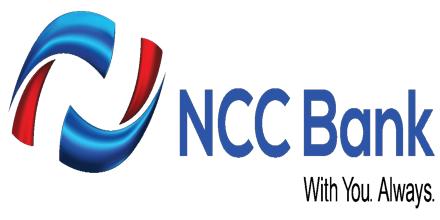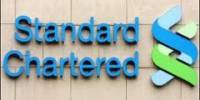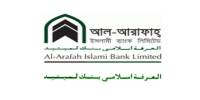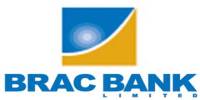Banking Overview of NCC Bank Limited
A bank is a financial institution and a financial intermediary that accepts deposits and channels those deposits into lending activities, either directly or through capital markets. A bank connects customers that have capital deficits to customers with capital surpluses. Banks act as payment agents by conducting checking or current accounts for customers, paying checks drawn by customers on the bank, and collecting checks deposited to customers’ current accounts. Banks borrow money by accepting funds deposited on current accounts, by accepting term deposits, and by issuing debt securities such as banknotes and bonds. Banks lend money by making advances to customers on current accounts, by making installment loans, and by investing in marketable debt securities and other forms of money lending.
National Credit and Commerce Bank Ltd. bears a unique history of its own. The organization started its journey in the financial sector of the country as an investment company back in 1985. The aim of the company was to mobilize resources from within and invest them in such way so as to develop country’s Industrial and Trade Sector and playing a catalyst role in the formation of capital market as well. Its membership with the browse helped the company to a great extent in these regard. The company operated up to 1992 with 16 branches and thereafter with the permission of the Central Bank converted into a fully fledged private commercial Bank in 1993 with paid up capital of Tk. 39.00 crore to serve the nation from a broader platform.
Since its inception NCC Bank Ltd. has acquired commendable reputation by providing sincere personalized service to its customers in a technology based environment.
The Bank has set up a new standard in financing in the Industrial, Trade and Foreign exchange business. Its various deposit & credit products have also attracted the clients-both corporate and individuals who feel comfort in doing business with the Bank.
Current Banking Scenario in Bangladesh
When Bangladesh came into existence on the 16th December, 1971, the banking sector of Bangladesh was in total disarray. With the exception of two local banks incorporated in the East Pakistan, all the bigger local banks became in operational. Starting with such a humble condition, the Banking Sector of Bangladesh has grown to a great extent. At present there are 49 banks in Bangladesh. The structure of Banking in Bangladesh is under:
Nationalized Commercial Banks – 4
Specialized Banks- 4
Private sector Commercial Banks:
a) Conventional Banks – 25
b) Islamic Banks – 5
Foreign Commercial Banks:
a) Conventional Banks- 9
b) Islamic Banks – 1
Sonali Bank is the largest among the NCBs while Pubali is leading in the private ones. Among the foreign banks, Standard Chartered has become the largest in the country. Besides the scheduled banks, Samabai (Cooperative) Bank, Ansar-VDP Bank, Karmasansthan (Employment) Bank and Grameen bank are functioning in the financial sector. The number of total branches of all scheduled banks is 6,038 as of June 2000. Of the branches, 39.95 per cent (2,412) are located in the urban areas and 60.05 per cent (3,626) in the rural areas. Of the branches NCBs hold 3,616, private commercial banks 1,214, foreign banks 31 and specialized banks 1,177.
Bangladesh Bank (BB) regulates and supervises the activities of all banks. The BB is now carrying out a reform program to ensure quality services by the banks. Bangladesh Bank (BB) has been working as the central bank since the country’s independence. Its prime jobs include issuing of currency, maintaining foreign exchange reserve and providing transaction facilities of all public monetary matters. BB is also Bangladesh Bank (BB) has been working as the central bank since the country’s independence. Its prime jobs include issuing of currency, maintaining foreign exchange reserve and providing transaction facilities of all public monetary matters. BB is also responsible for planning the government’s monetary policy and implementing it thereby.
The BB has a governing body comprising of nine members with the Governor as its chief. Apart from the head office in Dhaka, it has nine more branches, of which two in Dhaka and one each in Chittagong, Rajshahi, Khulna, Bogra, Sylhet, Rangpur and Barisal.
NCC Bank Mission, Vision & Objective
Corporate Vision
“To become the Bank of choice in serving the Nation as a progressive and Socially Responsible financial institution by bringing credit & commerce together for profit and sustainable growth.”
Corporate Mission
“To mobilize financial resources from within and abroad to contribute in Agriculture’s, Industry & Socio-economic development of the country and to play a catalytic role in the formation of capital market.”
Objective
No information was found publicly disclosed regarding the banks short and long term strategic or financial objective.
NCCBL believe in its uncompromising commitment to fulfill client’s needs and satisfaction and to become their first choice in banking. Taking cue from its pool esteemed clientele, the bank intends to pave the way for a new era in banking that holds and epitomizes its vaunted Marques “where Credit and commerce integrates”
NCC Bank in Bangladesh at a glance
NCC Banks current market situation is given below with graphical presentation:
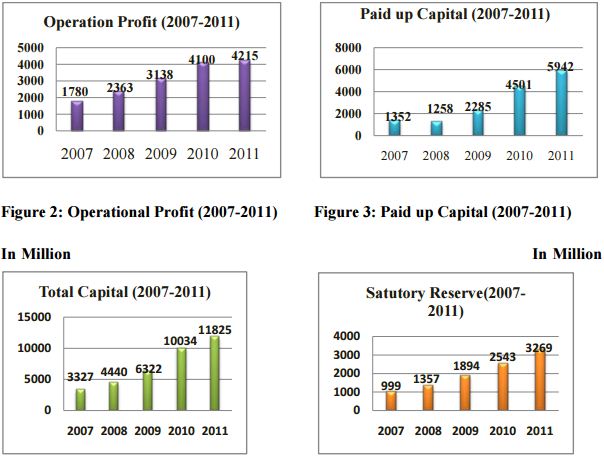
Competitors
According to CAMEL Rating NCC Bank is on satisfactory level or B-class Banks. Other Banks which fall in B category are NCC Bank’s competitor. The competitors of NCC Bank are- South East Bank Ltd (SEBL),Eastern Bank Limited (EBL), Bangladesh Commerce Bank (BCB), Basic Bank and. According to 2011 data NCC Bank has authorized capital Tk. 10000 million and paid up capital 5941.65 million. South East Bank has authorized capital Tk. 10000 million and paid up capital is 363 million. Eastern Bank Limited has authorized capital Tk4500 million and paid up capital was above Tk. 2659 million. Authorized capital of Bangladesh Commerce Bank is Tk. 2000 million and paid up capital is Tk 920 million. Of the paid up capital, government contribution is Tk. 300 million and Tk. 520 million came from deposits in former BCI fund and rest were collected from three public sector banks. Basic Bank has authorized capital Tk. 2000 million and paid up capital Tk 1964.65 million.
The divisions of NCC Bank are:
The General Banking Division
General Banking also termed as retail banking, is the division where all the banking operation starts for a commercial bank. The division provides day to day services to the clients regarding opening new accounts, remittance funds, issuing pay order and demand drafts and so on. It is divided in to some important sections, described below with relevant elaborations:
Deposit Section
The deposit section serves as the stepping stone to an individual for becoming a valued client of NCCBL. A potential client has a number of options to choose from regarding his/her account type of choice.
Cash Transaction Section
The cash transaction section manages all types of banking services related to receiving and paying cash money and the busiest section. It includes the vault of the branch. This section has to deal with a wide variety of tasks, among which the most common ones are:
- Receiving and paying cash to account holders.
- Receiving bill payments of various community services like: Electricity, WASA, T&T, Banglalion, Grameen Phone, Robi etc.
- Working as agent at the time of issuing IPOs of different companies.
- Managing cash transactions of Debit Cards, Credit Cards, Pay Order, Demand Draft & Foreign Remittance.
Clearing & Collection Section
Collection of checks, drafts etc. on behalf of the clients is one of the most basic function of a commercial bank. Clearing stands for mutual settlement of claims made in between member banks at an agreed time and place in respect of instruments drawn on each other. Checks, dividends, warrants and other forms of financial instruments easy for encashment are received in this section of any branch of NCCBL, are sent to the clearing house of Bangladesh Bank for collection. The clearing house does the following steps:
Clearing House
The claims of contracting parties are settled in clearing house. In case of cheque clearing, it is an arrangement under which member banks agree to meet, through their representatives, at appointed time and place to deliver instruments for mutual settlement of claims made among member banks at an agreed time and place in respect of instruments drawn on each other. The claims/payments are settled through banker’s accounts of member banks.
Clearing Process: Steps
Step 1: processing of cheques by the collecting branch (outward clearing)
Step 2: processing by the principal branch/local office (consolidation)
Step 3: cheques presented in clearing house and distribution to drawee bank by Bangladesh Bank/Sonali Bank.
Step 4: payment advice by the drawee bank (inward clearing)
Step 5: update return, over payment/under payment (return)
The Card Division
NCCBL launched its VISA Card services on August 22, 2005. The bank offers three different card types with brand names. The description of different types of Credit Cards & Debit Cards will describe in the project part of the report.
The Credit Division
The Credit Division of NCCBL manages the single most significant source of income of the bank- the bank loans. Since Bangladesh has a seemingly inefficient capital market, bank loans still serve as the major source of capital for the economy in general. Managing its credit operations is therefore the task defining the banks performance. For the proper & careful management of the hard earned deposits of its accounts holders, NCCBL has gradually developed a well- organized & skillful group of professional bankers.
The Foreign Exchange Division
The foreign exchange division of NCCBL has been organized with three major sections for the ease of its operations- the import, export and foreign remittance section.
Import Section
According to the Import & Export Control Act 1950, the Office of Chief Controller of Import and Export provides the registration (IRC) to the importer. The bank gives guarantee to the exporter that it will pay for the goods exported if the importer fails to pay. This guarantee is called LC i.e. Letter of Credit, and it’s the classical way of secured payment in international trade.
The key function of the import section is to manage and maintain all the tasks related to the banks LC operations. Apart from this, the section also plays its part in sanctioning LTR and LIM.
Export Section
The export section offers export LC services to local exporters, mostly of RMG. NCCBL provides extra cover to its clients throughout the entire export process with facilities like-
- Export Letter of Credit advising,
- Pre-shipment export financing,
- Export documents negotiation,
- LC confirmation, etc.
Foreign Remittance Section
According to Foreign Exchange Regulation Act, 1947, section3, commercial banks are titled as authorized dealers of foreign currencies, and with this authority, NCCBL foreign remittance section offers its clients convenient and legal ways of transferring, sending and receiving cash accounts in and from abroad, in addition to fulfilling all their currency conversion needs. Major services include-
- Inward and outward remittance service
- DD and TT issues
- DD and check collection
- Endorsements
- Travelers check issuance ( a seemingly obsolete service, but still has its uses)
The following services are available in NCCBL for transfer and receive money-
- Moneygram
- Xpress Money
- AFX
- Habib Qatar
- Dhaka Janata
- Placid Express
- ANB
- Walls street
- Turbo cash
- Kay Marks
- ITAU Unibanko
- UAE Exchange
- IME
- National Exchange
- MAJAN Exchange
- AL Zaman Exchange
- Federal Express
- Kushiara Express
The money sending and receiving process is done by swift technology.
SWOT ANALYSIS
A company’s present situation can be determined through the SWOT Analysis which indicates Strengths, Weakness, Opportunity and Threat. This has been
Strength
- Efficient Administration
- Healthy Financial vitals
- 200 crore profit in the year 2011
- Strong position in CAMEL rating
- Using SWIFT Technology & FLORA Software
- Good client- banker relationship
- High level of cooperation and cohesion among branches
Weakness
- Manual record keeping is still around
- Inadequate number of needed workforce in some branches
- Noticeable reluctance to arranging marketing campaign and promotion
Opportunity
- Huge potential of growth in sectors like online banking & ATM card
- Currently introduced SMS banking
- A steady GDP growth & other sectors means opportunities are always there for carefully designed, attractive services
- A country with a population of 160M comes with financial demands, where banks may significantly contribute with mutual benefits.
Threats
- A very recent prolonged massive crash in secondary market has created new challenges for the managers
- Financially powerful foreign banks with strong brand names would became the choice of big parties
- 9 more banks are about to established, number of competitors will increased
Strengths
Efficient Administration:
NCC Bank maintains transparency in its entire works. All decision of the Management comes through discussions in appropriate forum and required follow-ups are also made to see their effectiveness.
Healthy Financial vitals:
Due to declined flow of remittance in the first leg of the year 2011 owing to political turmoil or transition of power in some Middle Eastern countries there were some difficulties in running the affairs of the banks. Private Banks faced some difficulties in respect of sanctioning fresh loan and soaring exchange rate against US Dollar slowed down import of capital machineries’ as well as caused increase in inflationary rates. Due to strengthening NCC Bank’s position they have taken a new approach of centralizing opening of letter of credit administration brought discipline in documentation of loan before disbursement. It will also help secure quality of the assets and lower quantum of NPL in the coming days.
Strong position in CAMEL rating:
The Capital, Asset, Management, Earning, Liquidity and Sensitivity (CAMELS) rating of different commercial banks in 2008 were done recently by the regulatory authority. The serial is made on the basis of performance of 2007 and local banks first, then foreign banks. Based on CAMEL Rating NCC Bank’s performance is satisfactory.
SWIFT Technology & FLORA Software:
Swift Technologies’ services are designed to generate increased efficiency and business value in key functional areas such as finance, human resources, information technology, supply chain management, and CRM. And FLORA is a logic-based object-oriented language for building knowledge-intensive applications. It is based on F-logic, HiLog, and Transaction Logic. Applications include intelligent agents, Semantic Web, ontology management, and more. NCC Bank IT is headed by Mr. Tapan Kanti Sarkar, Executive Vice President & CTO and teamed with 45 dedicated IT personnel who work round the clock with a view to provide support in core banking Flora UBS software operations along with System, Hardware & Network maintenance support to its 80 Branches & 3 SME branches and Head Office including Chittagong Area office.
Good client- banker relationship:
NCC Bank has a dedicated work force they take their prime objective is to satisfy the needs of the customers. They are trying to reach a vast section of people to include them in the formal banking circle. Their network is expanding in that direction of course.
High level of cooperation and cohesion among branches:
NCC Bank has a very good interpersonal relationship among all the Branches.
Weaknesses
Manual record keeping:
Manual record keeping are still around NCC Bank. The chance of losing instrument and documents can get ruined for many unusual circumstances.
Inadequate number of needed workforce in some branches:
In Dhanmondi Branch more than 10 employees have been transferred to other branches in 1 year. So the workforce in Dhanmondi Branch became inadequate. Sometimes it’s really tough for them to manage the streams of clients.
Noticeable reluctance to arranging marketing campaign and promotion:
NCC Bank is not that much efficient in marketing campaign and promoting their products.
Opportunities
Huge potential of growth in sectors like online banking & ATM card:
Now a day’s everyone leads a very busy life. Online banking is a very good solution. People don’t have to go through a long traffic jam to deposit money in their account. People also fear to carry cash. Online banking and ATM Card has long term opportunity in Bangladesh.
Currently introduced SMS banking:
NCC Bank just introduced SMS Banking. The clients can now check their balance through SMS.
A steady GDP growth & other sectors means opportunities are always there for carefully designed, attractive services:
Steady GDP Growth rate in banking sectors shows opportunity in for banking sectors in Bangladesh.
financial demands:
The current population of Bangladesh is now 16 Million. Financial needs are also increasing as the population is increasing. So the financial institute like banks will have a huge demand.
Threats
Massive crash in secondary market:
The recent prolonged crash in secondary market has created many new challenges for managers.
Financially powerful foreign banks with strong brand names would became the choice of big parties :
There are many foreign banks are now in Bangladesh with a very strong brand name. big parties can go to those banks rather than the Bangladeshi bank.
New Banks:
Nine new banks will establish in Bangladesh by October2012. Competition will become tougher then.
NATURE OF JOB
NCC Bank Dhanmondi Branch is situated in an attractive commercial zone. It has been established in the year of 1999. It was the 9th branch of NCC Bank Ltd. Currently NCC Bank Ltd has 90 branches all over in Bangladesh. NCC Bank Dhanmondi Branch is on 9th position in terms of profit among all the branches. There are 34 staffs and executives in NCCBL Dhanmondi Branch. Last quarter profit of NCC Bank Dhanmondy Branch was 1421.97lac.
The job category of NCCBL has different divisions. These are:
Specific Responsibilities of the Job
I have joined NCCBL as an intern starting from 25th January to 25th April. The following terms and conditions have to be maintained which are as follows:
Work Location: Quality Center (1st Floor), 744 Satmsjid Road, Dhanmondy R/A. Dhaka, Bangladesh.
Time Period: The internship Program of NCCBL started from 25th January to 25th April.
Work Hours: I had to work from 10:00 am to 5:00pm from Sunday to Thursday.
Supervisor: I worked under the supervision of Sayeda Shammi Akter, Principal Officer of NCCBL.
Duties and Responsibilities: I have worked in several desks in my 3 months internship period. Different desks I had different duties and responsibilities. Such as-
Cash Department
When I have joined in NCCBL, my supervisor assigned me to work in cash department. My first two weeks I had worked for cash department in bill counter. Here my duties were:
– Give numbers to all the bills collected.
– Give seals on the bills.
– Note them on register copy.
– Calculate all the revenues and vats are collected.
Card Division
I had the following duties and responsibilities in card division:
Attended Phone Calls: I have attend several phone calls of the clients who want to know their balance. By using FLORA Software I told them what their balance is.
Gave Phone Calls: when the cards of the clients come from Head Office, I gave a call to that client to collect his/her card from Dhanmondy Branch.
Lost Instrument Registry: in case of lost instrument like: Pay Order, Demand Draft they maintain a register copy. I wrote down the pay order number, branch name and amount and then took signature of an authorized officer.
Pay Order Balancing: calculate the monthly balance of pay order.
Remittance Section
Remittance section I had the following duties and responsibilities:
Distribute forms: I gave forms to clients. There are two types of forms. For Moneygram there is one type of form and for rest of the services there is another form.
Filling up the Form: sometimes too old clients are unable to fill up their own form. I had filled up several forms.
Photocopy: here I have done photocopy of several types of documents.
Dispatch
Steps by the Paying Branch: Inward Bill for Collection-IBC
Step 1: Receive the bill from postal department and enter in to inward mail register.
Step 2: Send the bills department with their acknowledgement.
Step 3: Enter the bill in IBC register bills and fill up all column.
Step 4: Scrutiny the forwarding schedules.
Step 5: Present the bill in respective department (Deposit, Advance, Remittance etc)
Outward Bill for Collection
Step 1: Receive the bill from customer for collection. Scrutiny the instrument properly, affix stamp “Received for collection” on the counter foil of pay-in-slip.
Step 2: Processing the bill. Affix crossing, endorsement, OBC forwarding schedule bill.
Step3: pass the voucher and fill the pay-in-slip & forwarding schedule copy in pending file.
Step 4: pass the bill at an early date to dispatch department with their acknowledgement for presentment to drawee branch through reg: post.
Supplementary
Rest of the time I have done supplementary under general banking division. The process of supplementary is-
– First unstapled all the vouchers and separate them by debit vouchers credit vouchers.
– Separate all the white vouchers, checks, pay orders etc.
– Separate them by account number wise.
– Print the top sheet of the vouchers.
– Find the voucher by account number and put a tick mark on top sheet.
– Staple the vouchers with top sheet.
Different Aspect of the Job
While carrying out my duties and responsibilities in NCC Bank, if I would make mistakes such as, giving wrong information to the clients my supervisor would have to be responsible for this. Therefore, I had to do my task flawlessly.
Recommendation
There are lots of thing I have learned under all the departments of NCCBL.
- I got the opportunity to know the nature of corporate culture such as attending meeting with team, giving weekly updates about the task assigned to me, participate in organizing different internal shows going on in NCCBL. However I think that each department should think intern as their co workers rather than only intern. This is because many of the members do not want to share the kind of work they do and what sorts of task they usually do.
- at the end of the day we could not learn more. If they do not want to disclose then what is the use of keeping the interns since they are not learning effectively.
